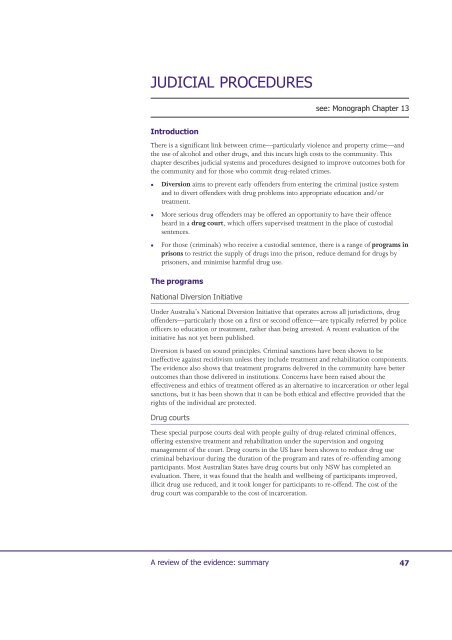Summary - Department of Health and Ageing
Summary - Department of Health and Ageing
Summary - Department of Health and Ageing
Create successful ePaper yourself
Turn your PDF publications into a flip-book with our unique Google optimized e-Paper software.
There is a significant link between crime—particularly violence <strong>and</strong> property crime—<strong>and</strong><br />
the use <strong>of</strong> alcohol <strong>and</strong> other drugs, <strong>and</strong> this incurs high costs to the community. This<br />
chapter describes judicial systems <strong>and</strong> procedures designed to improve outcomes both for<br />
the community <strong>and</strong> for those who commit drug-related crimes.<br />
<br />
<br />
<br />
Diversion aims to prevent early <strong>of</strong>fenders from entering the criminal justice system<br />
<strong>and</strong> to divert <strong>of</strong>fenders with drug problems into appropriate education <strong>and</strong>/or<br />
treatment.<br />
More serious drug <strong>of</strong>fenders may be <strong>of</strong>fered an opportunity to have their <strong>of</strong>fence<br />
heard in a drug court, which <strong>of</strong>fers supervised treatment in the place <strong>of</strong> custodial<br />
sentences.<br />
For those (criminals) who receive a custodial sentence, there is a range <strong>of</strong> programs in<br />
prisons to restrict the supply <strong>of</strong> drugs into the prison, reduce dem<strong>and</strong> for drugs by<br />
prisoners, <strong>and</strong> minimise harmful drug use.<br />
<br />
<br />
Under Australia’s National Diversion Initiative that operates across all jurisdictions, drug<br />
<strong>of</strong>fenders—particularly those on a first or second <strong>of</strong>fence—are typically referred by police<br />
<strong>of</strong>ficers to education or treatment, rather than being arrested. A recent evaluation <strong>of</strong> the<br />
initiative has not yet been published.<br />
Diversion is based on sound principles. Criminal sanctions have been shown to be<br />
ineffective against recidivism unless they include treatment <strong>and</strong> rehabilitation components.<br />
The evidence also shows that treatment programs delivered in the community have better<br />
outcomes than those delivered in institutions. Concerns have been raised about the<br />
effectiveness <strong>and</strong> ethics <strong>of</strong> treatment <strong>of</strong>fered as an alternative to incarceration or other legal<br />
sanctions, but it has been shown that it can be both ethical <strong>and</strong> effective provided that the<br />
rights <strong>of</strong> the individual are protected.<br />
<br />
These special purpose courts deal with people guilty <strong>of</strong> drug-related criminal <strong>of</strong>fences,<br />
<strong>of</strong>fering extensive treatment <strong>and</strong> rehabilitation under the supervision <strong>and</strong> ongoing<br />
management <strong>of</strong> the court. Drug courts in the US have been shown to reduce drug use<br />
criminal behaviour during the duration <strong>of</strong> the program <strong>and</strong> rates <strong>of</strong> re-<strong>of</strong>fending among<br />
participants. Most Australian States have drug courts but only NSW has completed an<br />
evaluation. There, it was found that the health <strong>and</strong> wellbeing <strong>of</strong> participants improved,<br />
illicit drug use reduced, <strong>and</strong> it took longer for participants to re-<strong>of</strong>fend. The cost <strong>of</strong> the<br />
drug court was comparable to the cost <strong>of</strong> incarceration.

















